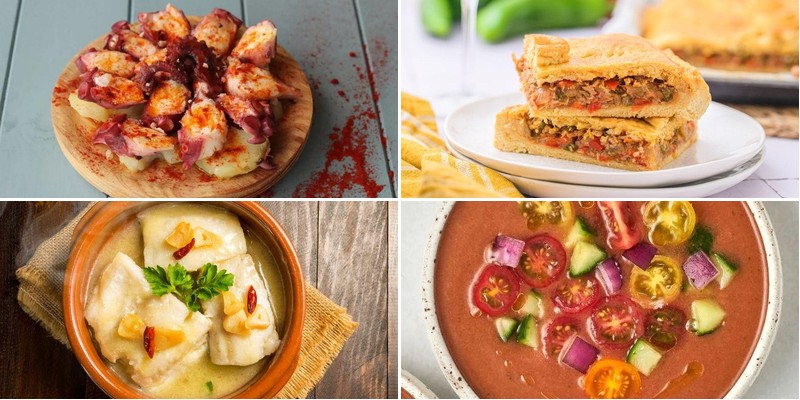Are you ready to bring the vibrant flavors of Spain into your kitchen? From sizzling paella to creamy gazpacho, these traditional Spanish recipes will transport your taste buds straight to the Mediterranean. Whether you’re craving comforting classics or festive tapas, this collection has something delicious for every home cook. Let’s dive into these irresistible dishes that will make your next meal an unforgettable Spanish fiesta!
Patatas Bravas

A classic Spanish tapas dish that transforms humble potatoes into crispy, flavorful bites perfect for sharing. Patatas bravas combines golden fried potatoes with a smoky, slightly spicy tomato sauce that will transport your taste buds straight to a Barcelona tapas bar. This methodical approach ensures even beginners can achieve restaurant-quality results at home.
Ingredients
– 2 lbs Yukon Gold potatoes, peeled and cut into 1-inch cubes (waxy potatoes hold shape better)
– 1/4 cup olive oil (or any neutral high-heat oil)
– 1 tsp smoked paprika
– 1/2 tsp cayenne pepper (adjust for desired heat level)
– 1 cup tomato sauce
– 2 tbsp white vinegar
– 3 garlic cloves, minced
– 1 tsp salt
Instructions
1. Preheat your oven to 425°F and line a baking sheet with parchment paper.
2. Place potato cubes in a large bowl and toss with olive oil until evenly coated.
3. Arrange potatoes in a single layer on the prepared baking sheet, ensuring they don’t touch for maximum crispiness.
4. Bake for 25 minutes, then flip each potato piece using tongs for even browning.
5. Continue baking for another 20-25 minutes until potatoes are golden brown and crispy on all edges.
6. While potatoes bake, combine tomato sauce, minced garlic, smoked paprika, cayenne pepper, and vinegar in a small saucepan.
7. Simmer the sauce over medium-low heat for 15 minutes, stirring occasionally to prevent sticking.
8. Remove potatoes from oven and immediately sprinkle with salt while still hot for better absorption.
9. Transfer crispy potatoes to a serving dish and drizzle the warm sauce over the top.
Unbelievably crispy on the outside yet fluffy inside, these potatoes contrast beautifully with the smoky, tangy sauce that clings to every crevice. For an authentic tapas experience, serve immediately with toothpicks for sharing, or top with a fried egg for a complete meal that showcases the sauce’s rich paprika flavor against the creamy yolk.
Spanish Tortilla
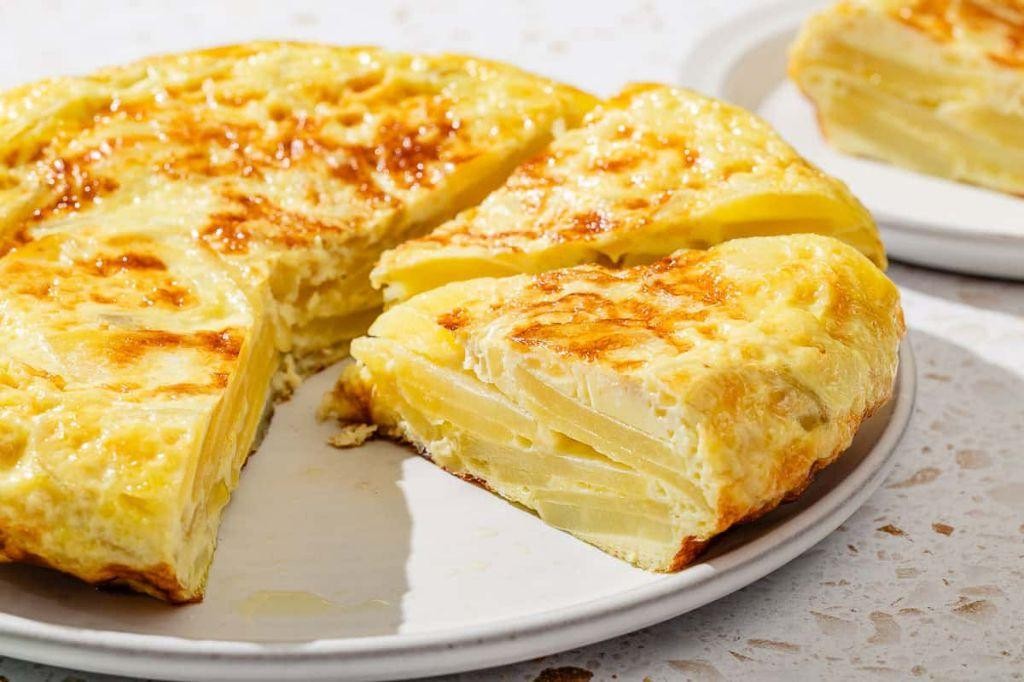
Every home cook should master the Spanish tortilla, a deceptively simple potato and egg dish that transforms humble ingredients into something truly special. Essentially a thick, sturdy omelet, it’s perfect for any meal of the day, from a hearty breakfast to a satisfying tapas-style dinner. Let’s walk through the process methodically to ensure your first attempt is a success.
Ingredients
– 1 ½ lbs Yukon Gold potatoes, peeled and thinly sliced (about 1/8-inch thick for even cooking)
– 1 large yellow onion, thinly sliced (sweet varieties like Vidalia work well)
– 6 large eggs
– 1 cup extra virgin olive oil (or a neutral oil like canola for a milder flavor)
– 1 tsp kosher salt (adjust to taste, but don’t skimp—it seasons the potatoes)
– ½ tsp black pepper, freshly ground
Instructions
1. Heat 1 cup of olive oil in a 10-inch nonstick skillet over medium heat until it shimmers, about 2–3 minutes. Tip: Test the oil by adding one potato slice; it should sizzle gently without smoking.
2. Carefully add all the sliced potatoes and onions to the hot oil, spreading them into an even layer.
3. Cook the potatoes and onions for 20–25 minutes, stirring occasionally with a spatula, until the potatoes are tender but not browned. Tip: Keep the heat at a steady medium to avoid crisping the potatoes—you want them soft.
4. While the potatoes cook, crack 6 eggs into a large bowl and whisk vigorously with 1 tsp salt and ½ tsp pepper until frothy and fully combined.
5. Place a fine-mesh strainer over a heatproof bowl, then pour the cooked potato-onion mixture into the strainer to drain excess oil; reserve the oil for future use.
6. Let the drained potatoes and onions cool for 5 minutes, then gently fold them into the egg mixture until evenly coated.
7. Wipe the same skillet clean with a paper towel, then return it to medium-low heat and add 1 tbsp of the reserved oil.
8. Pour the egg-potato mixture into the skillet, spreading it evenly with a spatula.
9. Cook for 8–10 minutes, shaking the skillet occasionally, until the edges are set and the bottom is golden brown. Tip: To check if the bottom is done, lift an edge with a spatula—it should release easily and be lightly browned.
10. Place a large, flat plate upside down over the skillet, then firmly grip the skillet handle and plate together and flip the tortilla onto the plate.
11. Slide the tortilla back into the skillet, uncooked side down, and cook for another 5–7 minutes until the center is firm but still slightly soft.
12. Transfer the cooked tortilla to a cutting board and let it rest for 5 minutes before slicing. A properly made Spanish tortilla boasts a creamy, almost custardy interior encased in a golden, firm exterior. Serve it warm or at room temperature, cut into wedges, or cube it for easy appetizer picks—either way, its rich, savory flavor shines.
Paella Valenciana
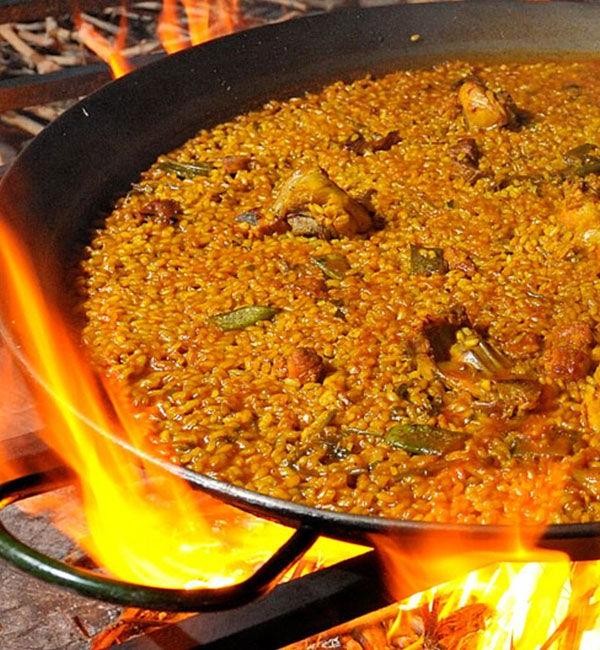
Let’s dive into making authentic Paella Valenciana, a Spanish classic that transforms simple ingredients into a vibrant, communal feast. Learning this methodical approach ensures you achieve the perfect socarrat—that coveted crispy rice bottom—every time. Following these steps carefully will build layers of flavor in your pan, creating a dish that’s both impressive and deeply satisfying.
Ingredients
– 2 cups short-grain rice (such as Bomba or Arborio, which absorbs liquid well)
– 4 cups chicken broth (warm it slightly before using for even cooking)
– 1 lb boneless chicken thighs, cut into 1-inch pieces (thighs stay juicier than breast)
– 1/2 lb rabbit meat, cut into chunks (or substitute with additional chicken)
– 1/2 cup extra-virgin olive oil (or any neutral oil for high-heat cooking)
– 1 large onion, finely diced
– 4 cloves garlic, minced
– 1 red bell pepper, sliced into strips
– 1 tomato, grated (discard the skin for a smoother sauce base)
– 1 tsp smoked paprika
– 1 pinch saffron threads (toast lightly first to enhance aroma)
– 1 cup frozen lima beans (thawed, or use fresh if available)
– 1 cup frozen green beans (thawed, trimmed and cut into 1-inch pieces)
– Salt, to season layers as you go
Instructions
1. Heat the olive oil in a 15-inch paella pan over medium-high heat until it shimmers.
2. Season the chicken and rabbit pieces with salt and add them to the pan in a single layer.
3. Sear the meat for 4-5 minutes per side until golden brown, then remove and set aside.
4. Add the diced onion to the pan and sauté for 3 minutes until translucent.
5. Stir in the minced garlic and cook for 1 minute until fragrant.
6. Add the grated tomato and cook for 4 minutes until it darkens and thickens.
7. Sprinkle in the smoked paprika and toasted saffron threads, stirring for 30 seconds to bloom the spices.
8. Tip: Toasting saffron in a dry pan for 20 seconds before crushing releases its full floral aroma.
9. Pour in the warm chicken broth and bring to a steady simmer.
10. Add the short-grain rice, distributing it evenly across the pan with a spoon.
11. Arrange the seared meat, lima beans, green beans, and bell pepper strips over the rice.
12. Do not stir the paella after this point to develop the socarrat.
13. Cook uncovered over medium heat for 18 minutes, rotating the pan occasionally for even heating.
14. Tip: Listen for a faint crackling sound—this indicates the socarrat is forming.
15. Increase the heat to high for the final 2 minutes to crisp the bottom layer.
16. Remove the pan from heat and cover with a clean kitchen towel for 5 minutes to steam.
17. Tip: Letting the paella rest allows the grains to absorb any remaining liquid evenly.
Perfectly cooked Paella Valenciana boasts a textured contrast: tender rice grains, juicy meat, and that signature crispy bottom. Serve it directly from the pan with lemon wedges for a bright, acidic kick that cuts through the richness.
Churros with Chocolate

Every time I bite into a warm, cinnamon-sugar coated churro dipped in rich chocolate sauce, I’m transported to my favorite street fairs. These crispy fried dough treats are surprisingly simple to make at home with just a few basic ingredients. Let me walk you through creating this classic Spanish dessert that’s perfect for sharing with friends and family.
Ingredients
- 1 cup water
- 2 tbsp granulated sugar
- ½ tsp salt
- 4 tbsp unsalted butter, cut into pieces
- 1 cup all-purpose flour
- 2 large eggs, at room temperature
- 2 cups vegetable oil for frying (or any neutral oil with high smoke point)
- ½ cup granulated sugar for coating
- 1 tsp ground cinnamon
- 4 oz dark chocolate, chopped
- ½ cup heavy cream
Instructions
- Combine 1 cup water, 2 tablespoons sugar, ½ teaspoon salt, and 4 tablespoons butter in a medium saucepan.
- Heat the mixture over medium heat until it reaches a rolling boil and the butter has completely melted.
- Remove the saucepan from heat and immediately add 1 cup all-purpose flour all at once.
- Stir vigorously with a wooden spoon until the mixture forms a smooth ball that pulls away from the sides of the pan.
- Transfer the dough to a mixing bowl and let it cool for 5 minutes until warm but not hot to the touch.
- Add 2 eggs one at a time, beating thoroughly after each addition until the dough becomes smooth and glossy.
- Fit a piping bag with a large star tip and fill it with the churro dough.
- Heat 2 cups vegetable oil in a heavy-bottomed pot to 375°F, using a deep-fry thermometer for accuracy.
- Pipe 4-inch strips of dough directly into the hot oil, cutting each with kitchen scissors.
- Fry 3-4 churros at a time for 2-3 minutes per side until golden brown and crispy.
- Remove fried churros with a slotted spoon and drain on a paper towel-lined baking sheet.
- Combine ½ cup sugar and 1 teaspoon cinnamon in a shallow bowl while churros are still warm.
- Roll each warm churro in the cinnamon-sugar mixture until evenly coated on all sides.
- Place 4 ounces chopped dark chocolate and ½ cup heavy cream in a heatproof bowl.
- Heat the chocolate mixture over a double boiler, stirring constantly until smooth and fully melted.
- Serve warm churros immediately with the chocolate dipping sauce on the side.
Zesty cinnamon sugar creates that signature crackly exterior while the interior remains wonderfully soft and airy. The contrast between the warm, crispy churros and the cool, silky chocolate sauce is pure magic. For an extra special presentation, arrange them standing up in a tall glass with the dipping sauce in a small bowl alongside.
Gazpacho Andaluz
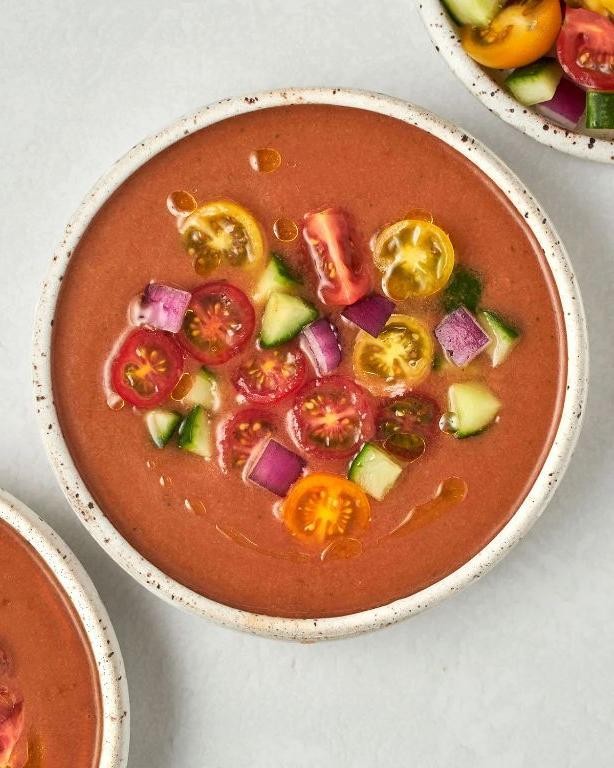
Unlock the refreshing simplicity of Spanish summer with this classic chilled soup that requires no cooking at all. Gazpacho Andaluz transforms ripe summer produce into a vibrant, cooling meal perfect for hot days when you want maximum flavor with minimal effort. You’ll be amazed how a handful of fresh ingredients blended together creates such complex, satisfying flavors.
Ingredients
– 2 pounds ripe tomatoes, cored and quartered (use the ripest you can find for best flavor)
– 1 medium cucumber, peeled and roughly chopped (English cucumbers work well)
– 1 small red bell pepper, seeded and chopped
– 1 small red onion, roughly chopped
– 2 garlic cloves, peeled
– 3 tablespoons extra virgin olive oil (a good quality oil makes a difference)
– 2 tablespoons sherry vinegar (red wine vinegar works as substitute)
– 1 teaspoon fine sea salt
– ½ teaspoon freshly ground black pepper
– 4 ice cubes (helps chill the soup quickly)
Instructions
1. Combine the quartered tomatoes, chopped cucumber, chopped bell pepper, chopped red onion, and peeled garlic cloves in a blender.
2. Add the olive oil, sherry vinegar, sea salt, and black pepper to the blender with the vegetables.
3. Place the 4 ice cubes into the blender with the other ingredients.
4. Blend the mixture on high speed for 45-60 seconds until completely smooth and no chunks remain.
5. Taste the blended soup and adjust seasoning if needed, adding more salt or vinegar in small increments.
6. Pour the gazpacho through a fine-mesh strainer into a large bowl to remove any seeds and skins for a silkier texture.
7. Press down on the solids in the strainer with a spatula to extract all the liquid from the pulp.
8. Transfer the strained gazpacho to an airtight container and refrigerate for at least 4 hours or until thoroughly chilled to 40°F.
9. Stir the chilled gazpacho well before serving to redistribute any settled ingredients.
10. Ladle the cold soup into bowls and serve immediately.
Hearty yet refreshing, this gazpacho delivers a perfect balance of sweet tomato brightness with the gentle kick of raw garlic and vinegar. The texture should be velvety smooth but substantial enough to feel satisfying in every spoonful. For a creative presentation, serve it in chilled glasses garnished with tiny diced vegetables or drizzle with extra olive oil just before serving for a beautiful finishing touch.
Pulpo a la Gallega
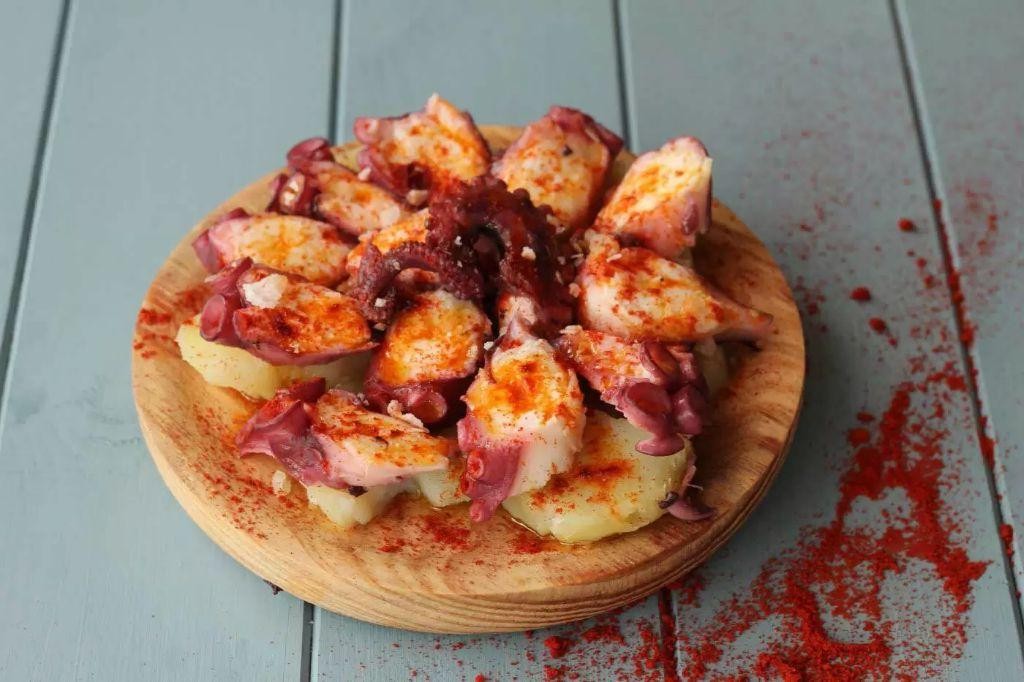
Even if you’ve never cooked octopus before, this Spanish classic is surprisingly approachable with the right technique. Pulpo a la Gallega transforms tender octopus into a stunning tapas dish that’s perfect for entertaining or a special weeknight meal.
Ingredients
– 2 lbs frozen octopus, thawed (freezing helps tenderize the meat)
– 2 large Yukon Gold potatoes, peeled and sliced into ½-inch rounds (they hold their shape well when boiled)
– ¼ cup extra virgin olive oil (a good quality Spanish variety if available)
– 1 tbsp smoked paprika (pimentón dulce for authentic flavor)
– 1 tsp coarse sea salt (Maldon salt works beautifully here)
– 1 bay leaf (for the boiling water)
– 2 cloves garlic, thinly sliced (optional, for extra flavor)
Instructions
1. Place the thawed octopus in a large pot and cover with cold water by 2 inches. 2. Add the bay leaf to the water and bring to a boil over high heat. 3. Once boiling, reduce heat to maintain a gentle simmer and cook for 45-60 minutes until tender when pierced with a fork. 4. While octopus cooks, place potato slices in a separate pot and cover with cold salted water. 5. Bring potatoes to a boil over high heat, then reduce to simmer for 15-20 minutes until easily pierced with a knife but not falling apart. 6. Drain potatoes thoroughly and arrange in a single layer on your serving platter. 7. When octopus is tender, remove from pot using tongs and let cool until handleable, about 5 minutes. 8. Using kitchen shears, cut octopus tentacles into ½-inch thick slices, discarding the head if preferred. 9. Arrange octopus slices over the potato rounds on your platter. 10. Drizzle olive oil evenly over the octopus and potatoes. 11. Sprinkle smoked paprika and coarse sea salt uniformly across the dish. 12. Scatter thinly sliced garlic over the top if using. Now you have a beautiful presentation of tender octopus over creamy potatoes. Notice how the smoky paprika complements the sweet brininess of the octopus, while the coarse salt provides satisfying texture contrasts. Serve this immediately as a stunning centerpiece for your tapas spread, or pair with crusty bread to soak up the flavorful olive oil.
Bacalao al Pil Pil
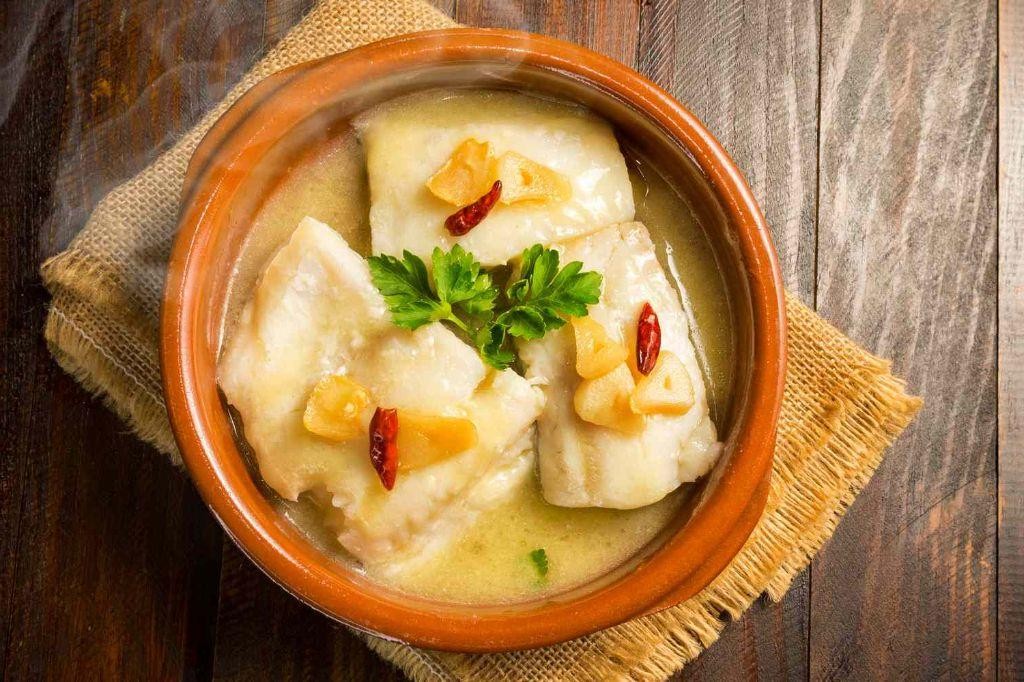
Eager to explore a classic Spanish dish with a fascinating technique? Bacalao al Pil Pil transforms simple salted cod into an emulsified masterpiece through patient, gentle cooking. This Basque specialty creates its own creamy sauce right in the pan, requiring careful temperature control and rhythmic pan movements to achieve the perfect texture.
Ingredients
– 1 pound salt cod fillets, soaked for 24-48 hours with multiple water changes to remove excess salt
– 1 cup extra virgin olive oil, or any high-quality olive oil for better flavor
– 6 garlic cloves, thinly sliced for even cooking and flavor distribution
– 2 dried guindilla peppers, or substitute with 1 teaspoon crushed red pepper flakes for heat
– 1/4 cup water, at room temperature to prevent temperature shock during emulsification
Instructions
1. Place the soaked salt cod fillets in a medium saucepan and cover completely with fresh cold water.
2. Heat the saucepan over medium heat until the water reaches 160°F, using a thermometer to monitor temperature.
3. Maintain the water at 160°F for 8 minutes, ensuring the cod cooks gently without boiling.
4. Remove the cod from the water and pat completely dry with paper towels, as moisture prevents proper emulsification.
5. Use your fingers to flake the cod into 2-inch pieces, removing any bones or dark skin for better texture.
6. Pour the olive oil into a small, heavy-bottomed skillet and heat over low heat for 2 minutes.
7. Add the sliced garlic to the oil and cook for 3 minutes until golden but not browned, stirring constantly.
8. Add the dried peppers to the oil and cook for 1 minute until fragrant, being careful not to burn them.
9. Arrange the cod pieces in a single layer in the skillet, ensuring they’re fully submerged in oil.
10. Cook over the lowest possible heat for 15 minutes, moving the skillet in constant circular motions to create emulsion.
11. Gradually add the room temperature water while continuing to move the skillet, watching for the sauce to thicken and turn creamy white.
12. Continue the circular pan movements for 5 more minutes until the sauce fully emulsifies and coats the back of a spoon. Zesty and luxurious, the resulting sauce should cling to the cod with a silky, mayonnaise-like consistency that contrasts beautifully with the firm fish. Serve this immediately in shallow bowls with crusty bread for dipping, or pair with steamed potatoes to absorb every drop of the garlic-infused emulsion.
Empanadas Gallegas
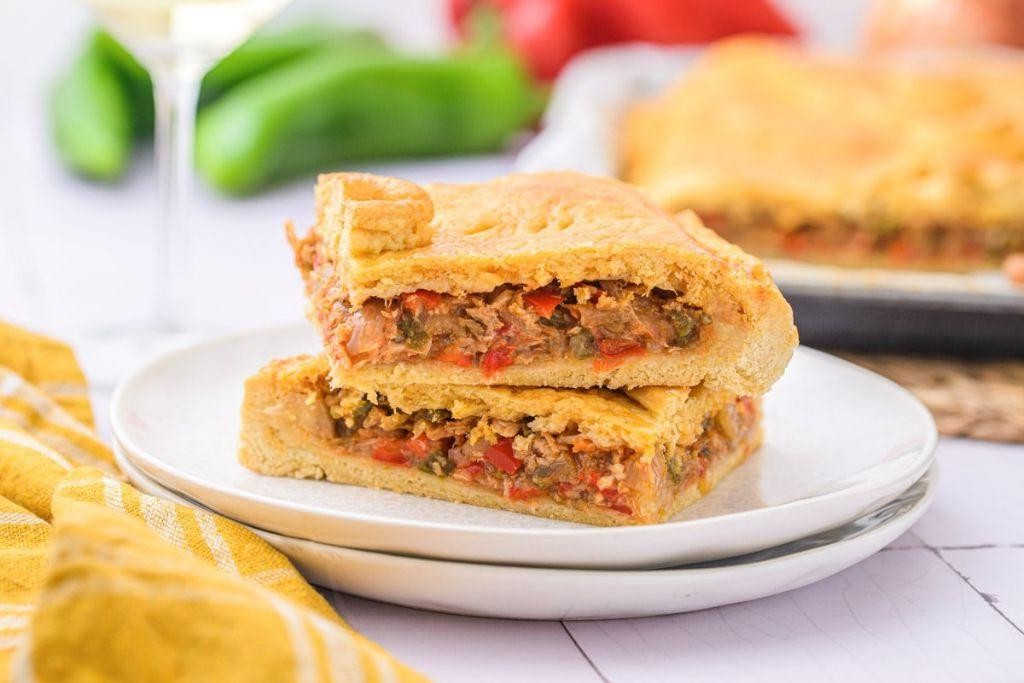
Diving into Spanish comfort food, empanadas gallegas offer a satisfying handheld meal perfect for busy weeknights. These savory pastries feature a flaky crust enveloping a simple, flavorful tuna and tomato filling that comes together with minimal fuss. Following these methodical steps will ensure your first attempt yields golden, perfectly baked empanadas every time.
Ingredients
– 2 cups all-purpose flour (plus extra for dusting)
– ½ cup warm water (about 110°F)
– ¼ cup olive oil (or any neutral oil)
– 1 tsp active dry yeast
– 1 tsp salt
– 1 can (5 oz) tuna in oil, drained
– ½ cup tomato sauce (canned works well)
– 1 small onion, finely diced
– 2 tbsp olive oil for sautéing
– 1 egg, beaten (for egg wash)
Instructions
1. Combine 2 cups flour, 1 tsp salt, and 1 tsp active dry yeast in a large mixing bowl.
2. Create a well in the center and pour in ½ cup warm water and ¼ cup olive oil.
3. Stir with a wooden spoon until a shaggy dough forms, then knead on a floured surface for 8 minutes until smooth and elastic.
4. Place dough in a lightly oiled bowl, cover with a damp cloth, and let rise in a warm spot for 1 hour until doubled in size.
5. While dough rises, heat 2 tbsp olive oil in a skillet over medium heat and sauté 1 diced onion for 5 minutes until translucent.
6. Add ½ cup tomato sauce and cook for 3 minutes until slightly thickened.
7. Remove skillet from heat and stir in drained tuna until fully incorporated, then cool completely.
8. Punch down risen dough and divide into 8 equal portions on a floured surface.
9. Roll each portion into a 6-inch circle about ⅛-inch thick using a rolling pin.
10. Place 2 tbsp filling in the center of each circle, leaving a ½-inch border.
11. Fold dough over filling to create a half-moon shape and press edges firmly to seal.
12. Crimp edges with a fork to ensure no leakage during baking.
13. Arrange empanadas on a parchment-lined baking sheet and brush tops with beaten egg wash.
14. Bake at 375°F for 20-25 minutes until golden brown and flaky.
15. Transfer to a wire rack and cool for 5 minutes before serving.
Serving these warm reveals a flaky, tender crust that shatters with each bite, contrasting beautifully with the savory tuna filling. The simple tomato-onion base allows the quality of your ingredients to shine through clearly. For a creative twist, try drizzling them with garlic aioli or serving alongside a crisp green salad for a complete meal.
Croquetas de Jamón

Gently transforming humble ingredients into golden, crispy delights, croquetas de jamón bring Spanish tapas magic to your kitchen with their creamy ham-filled centers and satisfying crunch. Mastering these requires patience and attention to technique, but the rewarding results make every step worthwhile. Follow this methodical approach to create authentic croquetas that will transport your taste buds straight to a Spanish café.
Ingredients
– 4 tablespoons unsalted butter (use European-style for richer flavor)
– 1/2 cup all-purpose flour (spoon and level for accuracy)
– 2 cups whole milk (warmed to about 110°F)
– 1 cup finely diced serrano ham (substitute with prosciutto if unavailable)
– 1/4 teaspoon freshly grated nutmeg (enhances the creamy flavor)
– 2 large eggs (room temperature for better coating)
– 1 cup fine breadcrumbs (panko works for extra crunch)
– 4 cups vegetable oil (or peanut oil for higher smoke point)
– 1 teaspoon kosher salt (adjust based on ham saltiness)
Instructions
1. Melt 4 tablespoons of unsalted butter in a heavy-bottomed saucepan over medium heat until completely liquid and bubbling slightly.
2. Whisk in 1/2 cup all-purpose flour continuously for 2 minutes until the mixture forms a smooth paste and develops a nutty aroma.
3. Gradually pour in 2 cups of warmed whole milk while whisking constantly to prevent lumps from forming.
4. Cook the mixture over medium-low heat, stirring with a wooden spoon, until it thickens enough to coat the back of the spoon, about 5-7 minutes.
5. Remove the saucepan from heat and stir in 1 cup of finely diced serrano ham, 1/4 teaspoon freshly grated nutmeg, and 1 teaspoon kosher salt until evenly distributed.
6. Spread the mixture onto a parchment-lined baking sheet in an even layer about 1/2-inch thick.
7. Cover the baking sheet with plastic wrap pressed directly against the surface and refrigerate for at least 4 hours or until completely firm.
8. Use a tablespoon to portion the chilled mixture and roll between damp hands to form 2-inch cylindrical shapes.
9. Beat 2 large eggs in a shallow bowl until uniform in color and texture.
10. Place 1 cup of fine breadcrumbs in a separate shallow bowl.
11. Dip each shaped croqueta into the beaten eggs, ensuring complete coverage.
12. Roll the egg-coated croquetas in breadcrumbs, pressing gently to adhere a thick, even layer.
13. Heat 4 cups of vegetable oil in a deep pot to 350°F, using a thermometer for accuracy.
14. Fry 4-5 croquetas at a time for 3-4 minutes until deep golden brown, turning occasionally for even coloring.
15. Remove fried croquetas with a slotted spoon and drain on a wire rack over paper towels.
16. Let croquetas rest for 2 minutes before serving to allow the filling to set properly. Heavenly when served warm, these croquetas offer a satisfying contrast between the crisp, golden exterior and the velvety, ham-infused béchamel within. Host a tapas night by pairing them with garlic alioli for dipping or serve alongside a crisp green salad to cut through the richness.
Pisto Manchego
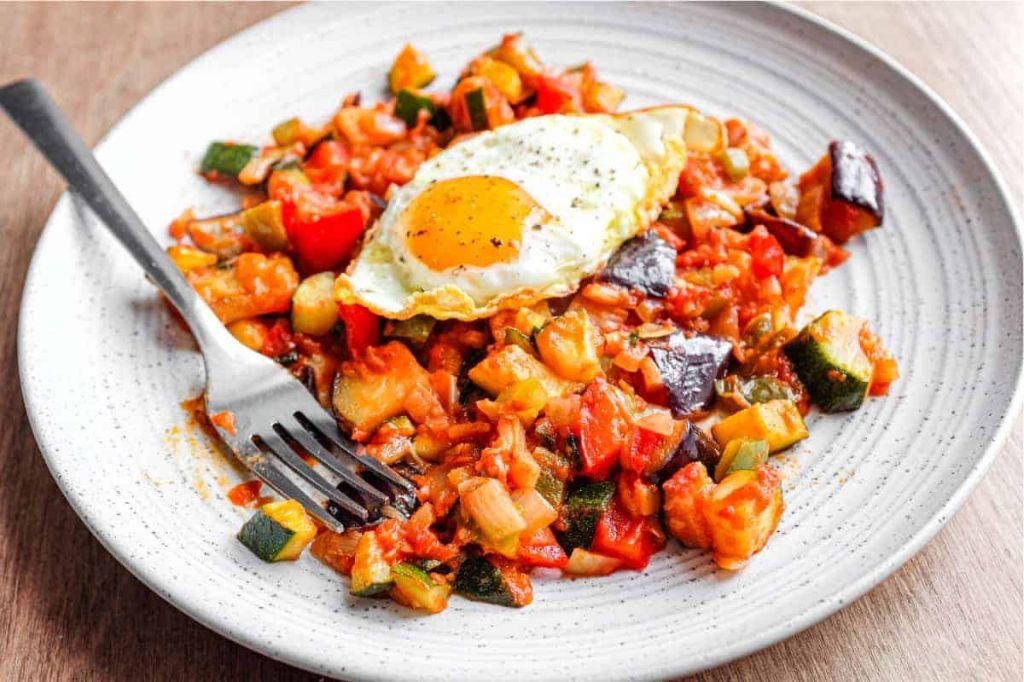
Looking for a comforting vegetable stew that celebrates seasonal produce? Pisto Manchego is Spain’s answer to ratatouille, featuring tender summer vegetables simmered in olive oil. Let’s walk through this simple, flavorful dish that works beautifully as a side or main course.
Ingredients
– 1/4 cup olive oil (or any neutral oil)
– 1 large yellow onion, diced
– 2 green bell peppers, seeded and chopped
– 2 medium zucchini, cut into 1/2-inch cubes
– 4 ripe tomatoes, peeled and chopped (or 1 28-oz can crushed tomatoes)
– 3 cloves garlic, minced
– 1 tsp salt (adjust to taste)
– 1/2 tsp black pepper
Instructions
1. Heat olive oil in a large Dutch oven over medium heat until it shimmers, about 2 minutes.
2. Add diced onion and cook until translucent, stirring occasionally for 5-7 minutes.
3. Stir in chopped bell peppers and cook until slightly softened, about 4 minutes.
4. Add zucchini cubes and cook until edges begin to brown, approximately 6 minutes.
5. Mix in minced garlic and cook until fragrant, 30 seconds.
6. Add chopped tomatoes, salt, and black pepper, stirring to combine all ingredients.
7. Reduce heat to low, cover the pot, and simmer for 25 minutes until vegetables are tender but not mushy.
8. Remove lid and cook uncovered for 10 minutes to thicken the sauce slightly.
9. Taste and adjust seasoning if needed before serving.
You’ll notice the vegetables maintain their distinct textures while the tomato base creates a rich, savory sauce. Try serving pisto manchego with fried eggs for breakfast or crusty bread for dipping—the flavors deepen beautifully when made ahead.
Cocido Madrileño
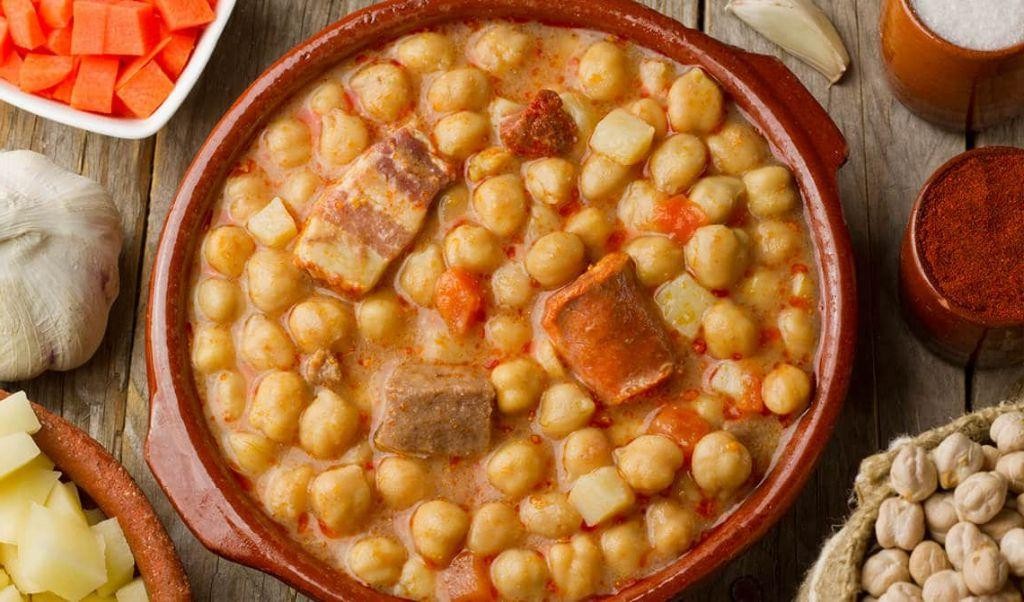
Finally, let’s explore Cocido Madrileño, a traditional Spanish stew that transforms humble ingredients into a deeply satisfying meal through careful layering and timing. Following this methodical approach ensures each component cooks perfectly while developing rich, complex flavors that define this classic dish.
Ingredients
– 1 lb beef chuck, cut into 2-inch cubes (or substitute beef shank for richer flavor)
– 8 oz smoked Spanish chorizo, sliced ½-inch thick (look for cured, firm texture)
– 1 ham hock, about 1 lb (pre-soaked 4 hours if very salty)
– 2 cups dried chickpeas, soaked overnight (or use 4 cups canned, drained)
– 1 large onion, quartered (yellow or white both work)
– 2 carrots, peeled and cut into 2-inch chunks
– 2 potatoes, peeled and quartered (Yukon Gold hold shape best)
– 4 cloves garlic, smashed (remove skins after cooking)
– 1 bay leaf
– 1 tsp black peppercorns
– 8 cups cold water (enough to cover ingredients by 2 inches)
– Salt to taste (add after tasting broth)
Instructions
1. Combine beef chuck, chorizo, ham hock, soaked chickpeas, onion, carrots, garlic, bay leaf, and peppercorns in a large stockpot. 2. Pour 8 cups cold water over ingredients, ensuring everything is submerged by at least 2 inches. 3. Bring to a boil over high heat, then immediately reduce to a gentle simmer where small bubbles just break the surface. 4. Skim off any foam that rises during the first 15 minutes using a slotted spoon. 5. Simmer uncovered for 1.5 hours, maintaining steady heat that keeps broth moving without vigorous boiling. 6. Add potatoes to the pot, submerging them in the broth. 7. Continue simmering 30 minutes until potatoes are fork-tender but not falling apart. 8. Remove ham hock and shred meat from the bone, discarding skin and bone. 9. Taste broth and season with salt only after this point to avoid over-salting. 10. Ladle broth into bowls first, then arrange meats and vegetables attractively over top. Our finished Cocido Madrileño presents tender chickpeas that pop with each bite against the firm potatoes and sweet carrots. The shredded ham hock and sliced chorizo create a savory contrast that makes this stew deeply comforting, especially when served with crusty bread for dipping into the rich, amber-colored broth.
Salmorejo Cordobés
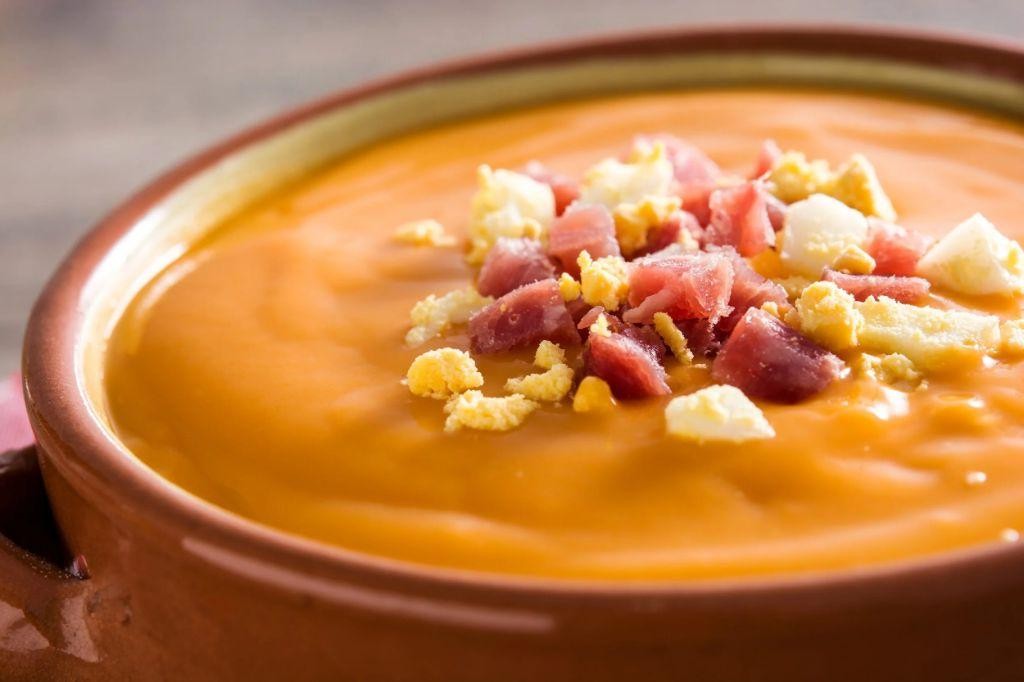
Zesty and refreshing, Salmorejo Cordobés is a chilled Spanish tomato soup that’s perfect for warm weather. This Andalusian classic requires just a few simple ingredients but delivers incredible depth of flavor. Let me guide you through creating this creamy, no-cook delight in your own kitchen.
Ingredients
- 2 pounds ripe tomatoes, cored and quartered (use the ripest tomatoes you can find for best flavor)
- 4 ounces day-old crusty bread, crusts removed and torn into chunks (about 2 cups packed)
- 1 small garlic clove, peeled (start with half if you’re sensitive to raw garlic)
- 1/2 cup extra virgin olive oil (a fruity Spanish variety works beautifully)
- 2 tablespoons sherry vinegar (red wine vinegar makes a good substitute)
- 1 teaspoon fine sea salt (adjust after blending if needed)
- 2 hard-boiled eggs, peeled and chopped (for garnish)
- 4 slices serrano ham, chopped (prosciutto works as an alternative)
Instructions
- Place the quartered tomatoes, bread chunks, and garlic clove in a blender jar.
- Blend on high speed for 2 full minutes until completely smooth and no bread pieces remain visible.
- With the blender running on medium speed, slowly drizzle in the olive oil over 30 seconds to create a stable emulsion.
- Add the sherry vinegar and sea salt to the blender jar.
- Blend for another 45 seconds until the mixture becomes pale orange and noticeably thicker.
- Pour the blended soup through a fine-mesh strainer into a large bowl, pressing with a spatula to extract all the liquid.
- Discard the small amount of solids remaining in the strainer.
- Cover the bowl tightly with plastic wrap, pressing it directly onto the soup’s surface to prevent oxidation.
- Refrigerate the soup for at least 4 hours, or ideally overnight, until thoroughly chilled to 40°F.
- Divide the chilled soup among 4 serving bowls.
- Sprinkle the chopped hard-boiled eggs evenly over each portion.
- Top each bowl with the chopped serrano ham, distributing it evenly.
- Drizzle each serving with an additional teaspoon of olive oil just before serving.
Just remember that the magic happens during the chilling time, when the flavors meld and the texture becomes luxuriously creamy. This velvety soup delivers bright tomato flavor balanced by the richness of olive oil and the tang of sherry vinegar. For a stunning presentation, serve it in clear glass bowls to show off the vibrant garnishes, or make individual shooter portions for a summer party appetizer.
Fabada Asturiana
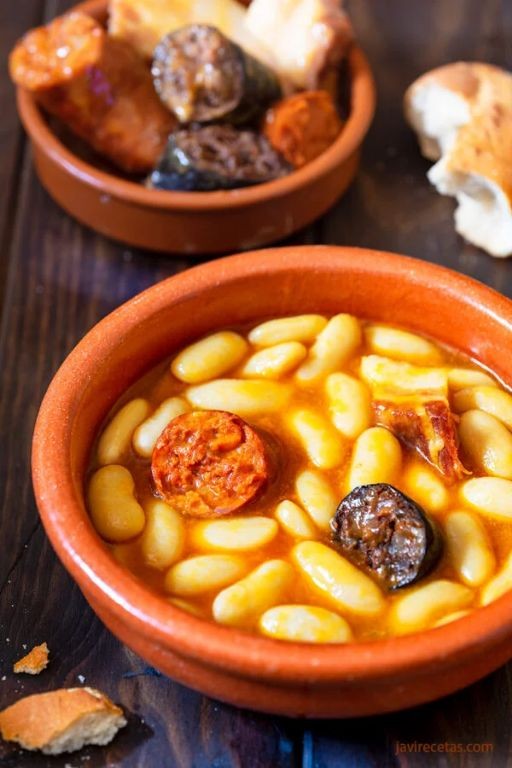
While traditional Spanish stews might seem intimidating, Fabada Asturiana is surprisingly approachable when broken down into clear steps. This hearty bean and sausage dish delivers incredible depth with simple ingredients, perfect for a comforting weekend meal. We’ll walk through each stage together to ensure your stew turns out rich and flavorful every time.
Ingredients
– 1 pound dried large white beans, soaked overnight (or use quick-soak method)
– 8 cups cold water, plus more as needed (for proper bean cooking)
– 1 tablespoon olive oil (or any neutral oil)
– 1 large yellow onion, diced (about 2 cups)
– 4 cloves garlic, minced (about 2 tablespoons)
– 1 teaspoon smoked paprika (for authentic Spanish flavor)
– 1/2 teaspoon saffron threads, crushed (or 1/4 teaspoon turmeric for color)
– 1 bay leaf (remove before serving)
– 1 pound Spanish chorizo, sliced 1/2-inch thick (or Portuguese linguiça)
– 1/2 pound smoked ham hock (or ham bone)
– 1 teaspoon salt (adjust in final seasoning)
– 1/4 teaspoon black pepper (freshly ground preferred)
Instructions
1. Drain the soaked beans and rinse under cold water in a colander.
2. Heat olive oil in a large Dutch oven over medium heat for 2 minutes until shimmering.
3. Add diced onion and cook for 8 minutes, stirring occasionally, until translucent.
4. Add minced garlic and cook for 1 minute until fragrant but not browned.
5. Stir in smoked paprika and cook for 30 seconds to toast the spices.
6. Add drained beans, 8 cups cold water, saffron, bay leaf, chorizo, and ham hock to the pot.
7. Bring to a boil over high heat, then immediately reduce to a gentle simmer.
8. Partially cover the pot and simmer for 2 hours, checking every 30 minutes to ensure beans remain submerged in liquid.
9. After 2 hours, test bean tenderness by pressing one between your fingers – it should yield easily.
10. Remove ham hock and let cool until safe to handle, about 15 minutes.
11. Shred the meat from the ham hock, discarding skin and bones.
12. Return shredded ham to the pot and stir to combine.
13. Season with salt and pepper, then simmer uncovered for 15 minutes to thicken the broth.
14. Remove bay leaf and discard before serving.
Zesty and deeply satisfying, this stew develops a creamy texture from the broken-down beans that coats each spoonful. The smoked paprika and saffron create a warm golden broth that perfectly complements the rich sausages. For a complete meal, serve it with crusty bread to soak up every last bit of the flavorful liquid.
Conclusion
Keen to bring Spain’s vibrant flavors to your kitchen? This collection of 22 traditional recipes offers authentic tastes for every occasion—from tapas to paella. We hope you find new favorites to share with loved ones! Try a dish, leave a comment with your top pick, and pin this article on Pinterest to save these irresistible recipes for your next culinary adventure.
